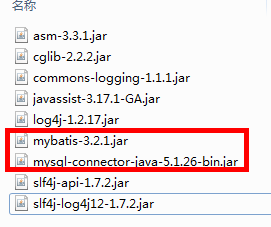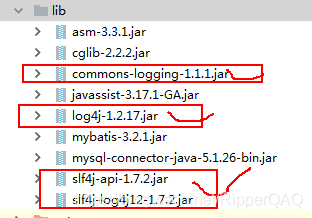mybatis(一)
mybatis是什么
(1)mybatis : 一个基于Java的持久层框架
(2)持久层 : 操作数据库那层代码
(项目分层:界面层(jsp/controller) 业务层(service层) 持久层(数据层 dao层))
持久层框架 : jdbc , springjdbc jpa springdatajpa , mybatis
(3) 框架:
a) 每个框架为了解决某一个领域问题产生
b)框架还是一个半成品, 已经完成一部分功能 ,只需要在上面进行开发 --提高开发效率
c) 可以让我们很多人写的代码 都按照一定规则去写–可读性 维护性
(4)持久化概念:
把内存里面数据 保存到数据库中 --过程就叫持久化
(5)mybatis 它是一个持久层框架,同时又是ORM的框架
ORM: 对象关系映射 --jpa/springdatajpa
Mybatis的特点
(1)MyBatis 是一个支持普通 SQL查询,存储过程(数据库mysql/oracle)和高级映射的优秀持久层框架。
(2)MyBatis ****消除了几乎所有的JDBC代码和手工设置参数以及结果集的检索****。
jdbc:
a) 贾琏欲执事 – 不需要做
b) 手工设置参数(传参) – 不需要做
insert into xxx (name,age) values(?,?)
c) 结果集 ResultSet(返回值) – 不需要做
(3)MyBatis 使用简单的 ****XML*或 注解 用于配置和原始映射,将接口和 Java 的*POJOs****(Plain Old Java Objects,普通的 Java对象 Employee/User/Entity/Domain)映射成数据库中的记录。 SQL映射方式
xxxMapper.xml 文件(crud sql语句)
面试题 : Jpa缓存
jpa 一级缓存 和二级缓存 是什么?
jpa 一级缓存: 属于entityManager级别缓存,jpa自带的,不用做任何配置, 命中条件
同一个entityManageFactory ,同一个EntityManager 同一个OID
二级缓存: 属于entityManagerFactory级别缓存,不是自带 ,需要做相应配置才行
命中条件
同一个entityManageFactory ,不同一个EntityManager 同一个OID
面试题:jdbc和mybatis优缺点?
jdbc和mybatis优缺点?
(1)jdbc操作步骤比较繁琐,比较执行贾琏欲执事 而mybatis不用 消除这个代码
(2)jdbc需要自己手动设置 参数 以及处理返回结果集 --而mybatis 不需要
(3)mybatis 可以采用 xml 和 注解 来写sql …jdbc 把sql 写到代码里面, 可以提高维护性
(4)jdbc 它是操作数据库最底层的代码,mybatis也是从jdbc上面封装出来框架 mybatis支持缓存
使用Mybatis
(1) 创建项目 导入jar包
a)创建一个普通项目 , 创建一个文件夹lib (jar包)
b)数据库创建一个表 Product
c)创建结构
cn.itsource.mybatis.domain
cn.itsource.mybatis.dao
cn.itsource.mybatis.service
(2) 做相应的配置
Mybatis-config.xml
<?xml version="1.0" encoding="UTF-8" ?>
<!DOCTYPE configuration PUBLIC "-//mybatis.org//DTD Config 3.0//EN"
"http://mybatis.org/dtd/mybatis-3-config.dtd">
<configuration>
<!-- 开发环境-->
<environments default="development">
<!--
一个环境 id:为这个环境取唯一一个id名称
-->
<environment id="development">
<!--
事务管理 type:JDBC(支持事务)/MANAGED(什么都不做)
mysql: innodb MyISAM
-->
<transactionManager type="JDBC" />
<!-- 数据源, 连接池 type(POOLED):MyBatis自带的连接池 -->
<dataSource type="POOLED">
<!-- 连接数据库的参数 四大金刚 -->
<property name="driver" value="com.mysql.jdbc.Driver" />
<property name="url" value="jdbc:mysql:///mybatis" />
<property name="username" value="root" />
<property name="password" value="123456" />
</dataSource>
</environment>
</environments>
<!-- 这个mappers代表的是相应的ORM映射文件 -->
<mappers>
<mapper resource="cn/itsource/mybatis/domain/ProductMapper.xml" />
</mappers>
</configuration>
ProductMapper.xml
<?xml version="1.0" encoding="UTF-8" ?>
<!DOCTYPE mapper
PUBLIC "-//mybatis.org//DTD Mapper 3.0//EN"
"http://mybatis.org/dtd/mybatis-3-mapper.dtd">
<!-- mapper映射配置 namespace:命名空间
以后:通过namespace+id 调用对应的语句
-->
<mapper namespace="cn.itsource.mybatis.domain.ProductMapper">
<!--
select:表示查询标签
id: 代表给标签取个名称 必须唯一
resultType:返回值类型
-->
<select id="findAll" resultType="cn.itsource.mybatis.domain.Product">
select * from product
</select>
</mapper>
(3) 写测试类测试一下
@Override
public List<Product> findAll() throws IOException {
//读取配置
Reader reader = Resources.getResourceAsReader("mybatis-config.xml");
//SqlSessionFactory -->EntityManagerFactory
SqlSessionFactory sqlSessionFactory = new SqlSessionFactoryBuilder().build(reader);
//SqlSession -->EntityManager
SqlSession sqlSession = sqlSessionFactory.openSession();
//调用findAll +namespace+id
List<Product> products = sqlSession.
selectList("cn.itsource.mybatis.domain.ProductMapper.findAll");
return products;
}
完成crud
<?xml version="1.0" encoding="UTF-8" ?>
<!DOCTYPE mapper
PUBLIC "-//mybatis.org//DTD Mapper 3.0//EN"
"http://mybatis.org/dtd/mybatis-3-mapper.dtd">
<!-- mapper映射配置 namespace:命名空间
以后:通过namespace+id 调用对应的语句
-->
<mapper namespace="cn.itsource.mybatis.domain.ProductMapper">
<!--
select:表示查询标签
id: 代表给标签取个名称 必须唯一
resultType:返回值类型
-->
<select id="findAll" resultType="cn.itsource.mybatis.domain.Product">
select * from product
</select>
<!--新增 parameterType 参数类型-->
<insert id="save" parameterType="cn.itsource.mybatis.domain.Product">
insert into product(productName,salePrice,costPrice,cutoff)
values(#{productName},#{salePrice},#{costPrice},#{cutoff})
</insert>
<!--修改-->
<update id="update" parameterType="cn.itsource.mybatis.domain.Product">
update product set productName=#{productName},salePrice=#{salePrice}
where id=#{id}
</update>
<!--删除 long Mybatis内置别名 long java.util.Long remove(13)-->
<delete id="remove" parameterType="long">
delete from product where id=#{id}
</delete>
<!--查询一条数据-->
<select id="findOne" parameterType="long" resultType="cn.itsource.mybatis.domain.Product">
select * from product where id=#{id}
</select>
</mapper>
工具类
枚举方式
public enum MybatisUtil {
INSTANCE;
private static SqlSessionFactory sqlSessionFactory;
//静态代码块
static{
Reader reader = null;
try {
reader = Resources.getResourceAsReader("mybatis-config.xml");
//SqlSessionFactory -->EntityManagerFactory
sqlSessionFactory = new SqlSessionFactoryBuilder().build(reader);
} catch (IOException e) {
e.printStackTrace();
}
}
//抽取一个 --sqlSession
public SqlSession getSqlSession(){
return sqlSessionFactory.openSession();
}
}
mybatis使用细节
细节1 – 主键问题
有时候 保存一条数据之后,需要拿到这条数据的主键,拿到之后可以做后续事情
场景:
角色的保存
useGeneratedKeys=“true” keyColumn=“id” keyProperty=“id”
<insert id="save" parameterType="cn.itsource.mybatis.domain.Product"
useGeneratedKeys="true" keyColumn="id" keyProperty="id">
insert into product(productName,salePrice,costPrice,cutoff)
values(#{productName},#{salePrice},#{costPrice},#{cutoff})
</insert>
细节2 --日志问题
(1)为什么要使用日志
有时候,需要打印的sql的信息 比如sql的传参数 返回值 – 必须使用日志
好处: 使用日志框架可以帮助我们进行分析与排错
(2)常见排错方式:
断点
System.out.println
输出日志
(3)日志框架:
a)自己写:
通过反射技术 ,可以拿到参数 可以方法 拿到返回值
b)log4j – 使用比较多
c)日志框架标准
以前没有日志框架的, 每个人处理日志 都不一样 …
日志标准 – slf4j(抽象标准) -->很多实现 logging,logback,log4j
(4)使用日志框架 log4j(掌握)
a)导入jar包
b)写一个配置文件
log4j.rootLogger=ERROR, stdout
日志等级(了解): OFF level > FATAL(致命) > ERROR(错误) > WARN (警告)>
# INFO (提示)> DEBUG (调试)> trace > ALL level(所有配置)\
#输出效果 如果你设置日志级别是trace,则大于等于这个级别的日志都会输出
# 关闭日志输出
#log4j.rootLogger=NONE 不想打印日志 就配置NONE
# WARN为一般警告,比如session丢失、
# INFO为一般要显示的信息,比如登录登出、
# DEBUG为程序的调试信息
# TRACE 堆栈信息
# 扫描包 配置自己包
#注意点 包名/配置等级 配置DEBUG/ALL
log4j.logger.cn.itsource=DEBUG/TRACE
#ConsoleAppender:输出控制台
log4j.appender.stdout=org.apache.log4j.ConsoleAppender
#layout: 格式样式
log4j.appender.stdout.layout=org.apache.log4j.PatternLayout
#采用下面的样式输出 [20191224]类名
log4j.appender.stdout.layout.ConversionPattern=%d %p [%c] - %m%n
细节3 – #与$区别
3点区别
(1) $ 取得对象里面的某个属性 比如 ${id} Long getId
${id}
# 都可以
(2)重点 # select * from product where productName = ? 预编译的对象
$ select * from product where productName = 罗技G500 拼接字符串方式
# 推荐使用 $ sql注入问题
(3)后面使用$的 orderby+limit 后面就order by age/id不需要添加引号
动态SQL
比如: 以前做高级查询的时候 select * from xx where … and …
高级查询核心内容:就是where后面拼接
<sql id="whereSql">
<where>
<if test="productName != null">
and productName = #{productName}
</if>
<if test="id != null">
and id = #{id}
</if>
</where>
</sql>
<select id="queryByCondition" parameterType="cn.itsource.mybatis.query.ProductQuery"
resultType="cn.itsource.mybatis.domain.Product">
select * from product
<include refid="whereSql"></include>
</select>
批量操作
批量删除–(列表页面 checkbox 多选框)
批量新增 -->(导入功能)
批量修改–>(基本不用)
批量查询–>(基本不用)
来源:CSDN
作者:RipperQAQ
链接:https://blog.csdn.net/RipperQAQ/article/details/103767130